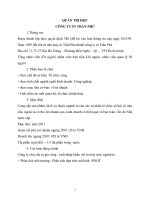English in Canada AustraliaNew Zealand Thuyết trình môn Đa dạng tiếng Anh
Bạn đang xem bản rút gọn của tài liệu. Xem và tải ngay bản đầy đủ của tài liệu tại đây (904.92 KB, 69 trang )
Topic 4
English in Canada/
Australia/New Zealand
Group 5
Trieu Thi Mai Hien
Kiem Hoang Oanh
Nguyen Thi Ngoc Thanh
Mai Tung Vi
Cao Thi My Duyen
ENGLISH
IN CANADA
AGENDA
1. The country and its settlement history
2. Canada as a linguistic area
3. Canada English – a descriptive account
The country and its
settlement history
Area: 9,984,670 sq.km
Canada is the second largest country
Population: About 32 million
Capital: Ottawa
The country and its settlement history
The name ‘Canada’ is derived from the indigenous Iroquois Indian word
Kanata ‘village’, ‘settlement’. It was taken up in the sixteenth century by
the first French explorers.
In 1763 the French were forced to cede all their North American colonies
to Britain with the exception of the small islands of Saint-Pierre and
Miquelon south-west of Newfoundland, which still belong to France.
Canada as a linguistic area
Multilingualism,
with special
reference to
French–English
bilingualism
Conflicting norms
and standards in
anglophone
Canada
Regional diversity
Multilingualism, with special reference to
French–English bilingualism
The Canadian government’s support of multiculturalism naturally
includes a celebration and promotion of multilingualism, that is ‘the
ability to speak, at some level, more than one language’.
Multilingualism, with special reference to
French–English bilingualism
At the federal level, Canada has two official languages: English, which is the
mother tongue of almost 60 percent of the population (the anglophones),
and French, with about 22 percent native speakers (the francophones).
At the provincial level, New Brunswick is officially bilingual and Quebec
monolingual French.
At the grassroots level, Canadian bilingualism is characterized by fluctuation
rather than stability.
Conflicting norms and standards in anglophone Canada
In Wells (1982:496) presentation of Canadian phonology, he accounts for
examples of hypercorrection not heard anywhere else in the English-speaking
world: words such as moon, noon, too are pronounced with /-ju/, that is
mistakenly adhering to a perceived British norm without yod dropping.
Example: The word colour, for example, was spelt with -our by more than 85
percent of Ireland’s informants in Ontario, but only by 30 per cent of those in
Alberta.
Conflicting norms and standards in anglophone Canada
A less obvious but equally important reason for the existence of double,
even conflicting, standards is of an attitudinal rather than regional
character. Until fairly recently, it has been fashionable to imitate British,
or rather EngE, speech as well as manners. The hypercorrect
pronunciation of moon highlights this fashion.
In part, the marked pro-British preferences had to do with antiAmerican attitudes. - > establishing an identity clearly distinct from the
USA.
Regional
diversity
As in the USA, the vast expanses in the
west are indeed fairly homogeneous,
whereas the eastern provinces where
English first arrived are remarkably rich
in dialects.
Other reasons are its special living
conditions and ways of life, and the
sizeable groups of early Englishspeaking immigrants from linguistically
distinctive areas.
Example : Devon, Cornwall, Scotland
and Ireland. There are many other
interesting enclave varieties, such as the
well-known German-influenced dialect
of Lunenburg, Nova Scotia (cf. In other
areas, rural dialects reflect input from
settlements representing various
language groups: Ukrainian, Italian,
Dutch, Scandinavian and, of course,
French.
Spelling
Canada English –
a descriptive account
Phonology
Grammar
Lexicon
Canada English –
a descriptive account
Canadian raising, a feature found in the lexical sets PRICE and MOUTH.
The motto for the section on Canada is a stereotypical American representation
of Canadian raising.
The use of the tag eh – another well-known Canadian stereotype; in fact, there
is even linguistic textbook called Canajan (Orkin 1997).
The occurrence of EngE-type lexical-distributional pronounciations (with a
short vowel), with the stress on the first syllable.
The unique use of certain lexical itemas, ofter ‘recycled’ English words and
French borrowings.
Spelling
Our vs Or
The British form is given as the first
alternative, it is has been found to be most
commonly used.
For example: Colour (also color).
Re vs Er
Here, too, the British form is given as the
first alternative.
For example: Centre, theatre, magre,
Ise (-yse) vs Ize (yze)
The American form is always given as the
first alternative, with the exception of
advertise which has no acceptable variant.
Spelling
Spelling is not a major issue in the
description of World Englishes, but in
the case of CanE it may function as a
marker of identify and shifting
attitudes.
According to Cochrane 1992, this may
be a trifling matter. But language is a
keystone of culture, and a culture is
distinguished by many subtle shadings
of sounds, looks and behavior. I say,
with uncontrite and u-ful fervour, let’s
keep vigour and ardour in our English!
PHONOLOGY
CanE phonology, like spelling, shows signs of vacillations between British and
American norms.
As for phonetic realisation, phonotactic distribution and phonemic systems, on the
other hand, CanE is in almost total agreement with GA.
Considering CanE realisations of the Wells sets, PRICE and MOUTH typically show
variation, being candidates for Canadian raising.
Whereas sociolinguistic studies in the late 1970s still demonstrate a great deal of
allophonic variation, more recent research suggests remarkable nationwide
convergence.
PHONOLOGY
MOUTH is towards the standards American phonetic realisation and that
it is led by young women.
The term ‘Canadian raising’ indicates, obviously, the phenomenon is the
result of a raising process.
Britain has emphasised that in analyses of ongoing linguistic change the
focus shout not exclusively be on the end result of the change but also
on what the change has develop from.
PRICE and MOUTH realisations similar to Canadian raising are.
PHONOLOGY
A few points will be made about some other aspects of the vowel
system.
Most Canadian accents have a single merged vowel phoneme for the
sets THOUGHT, CLOTH, LOT, PALM and START..
A well-know feature, used as one of the criteria for distinguishing varities
of English from each other.
An interesting sociolinguistic study are going a shift to the effect that
they are fronted.
PHONOLOGY
It has been suggested that the prestige of the new vocalic features are
reinforced by association with the speech of many national newscasters
in both USA and Canada.
CanE prosody doesn’t appear to be distinctive in any ways.
There are few truly distinctive features in CanE
Grammar.
There is no need for large text corpora now
available will probably reveal other cases where
CanE occupies an intermediate position.
GRAMMAR
Morphological characteristics include certain
forms in the strong verb system, of which some
have been subject to sociolinguistic studies.
It has an important conversational and narrative
function.
Nonstandard – especially traditional – dialect –
grammar typically reflects settlement history.
LEXICON
There is a general trend towards AmE vocabulary, but a quick
search for British vs American priorities in the Canadian Oxford
Dictionary resulted in a somewhat mixed pattern.
It is not quite clear which variant is the most frequent in the
dictionary database.
LEXICON
The above is only one aspect of CanE vocabulary, which is also
characterised by a great deal of innovation, partt due to the need
for new words for new surroudings, and naturally, borrowing as a
result of long-standing and intense contact with other varieties of
language.
Some lexical categories:
• Extension of meaning is found in name and types of vegetation.
• Ice hockey terms represent Canadianisms which have been
adopted in General English.
LEXICON
With reference to borrowing, French was an important donour
language, but only before the mid-nineteenth century.
Many place-names are the results of misinterpretations of French
words.
A great many French loanwords are restricted to certain regions.
Borrowings from Indian languages include: a meat dish, a shrub
with edible berries, thousands of place-name, the name of nation.
ENGLISH IN
AUSTRALIA
AGENDA
1. The country and its people
2. English in Australia – an overview
3. Australia English – a descriptive account









